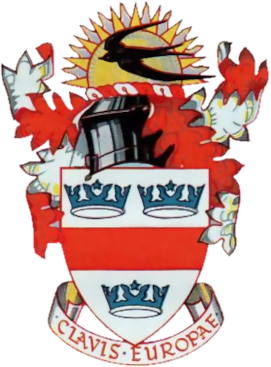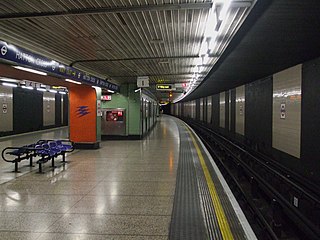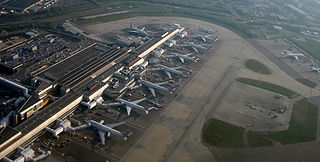
Heathrow Airport, also known as London Heathrow Airport and named London Airport until 1966, is the primary and largest international airport serving London, the capital and most populous city of England and the United Kingdom. It is the largest of the six international airports in the London airport system.

The London Borough of Hillingdon is a London borough in Greater London, England. It forms part of outer London and West London, being the westernmost London borough. It was formed in 1965 from the districts of Hayes and Harlington, Ruislip-Northwood, Uxbridge, and Yiewsley and West Drayton. The borough includes most of Heathrow Airport and Brunel University, and is the second largest of the 32 London boroughs by area.

London Gatwick, also known as Gatwick Airport, is the secondary international airport serving London, England. It is located near Crawley, West Sussex, England 29.5 miles (47.5 km) south of Central London. In 2022, Gatwick was the second-busiest airport by total passenger traffic in the UK, after Heathrow Airport, and was the 8th-busiest in Europe by total passenger traffic. It covers a total area of 674 hectares.

Berlin Tegel "Otto Lilienthal" Airport was the primary international airport of Berlin, the capital of Germany. The airport was named after aviation pioneer Otto Lilienthal and was the fourth busiest airport in Germany, with over 24 million passengers in 2019. In 2016, Tegel handled over 60% of all airline passenger traffic in Berlin. The airport served as a base for Eurowings, Ryanair and easyJet. It featured flights to several European metropolitan and leisure destinations as well as some intercontinental routes. It was situated in Tegel, a section of the northern borough of Reinickendorf, eight kilometres northwest of the city centre of Berlin. Tegel Airport was notable for its hexagonal main terminal building around an open square, which made walking distances as short as 30 m (100 ft) from the aircraft to the terminal exit.

Glasgow Airport, also known as Glasgow International Airport formerly Abbotsinch Airport, is an international airport in Scotland. It is located in Paisley, Renfrewshire, 8.6 nautical miles west of Glasgow city centre. In 2019, the airport handled 8.84 million passengers, an 8.4% annual decrease, making it the second-busiest in Scotland, after Edinburgh Airport, and the ninth-busiest airport in the United Kingdom.

British European Airways (BEA), formally British European Airways Corporation, was a British airline which existed from 1946 until 1974.

Hatton Cross is a combined London Underground station and bus station. It is located on the Heathrow branch of the Piccadilly line. It is in Travelcard Zones 5 and 6 and stands between the Great South West Road (A30) and the Heathrow Airport Southern Perimeter Road. The station serves a large area including Feltham to the south and Bedfont to the west. The station was named after the crossroads of the Great South West Road and Hatton Road.

GB Airways was a British airline; prior to its sale, it was headquartered in 'The Beehive', a former terminal building, at City Place Gatwick, London Gatwick Airport in Crawley, West Sussex, England.

British Eagle International Airlines was a major British independent airline that operated from 1948 until it went into liquidation in 1968. It operated scheduled and charter services on a domestic, international and transatlantic basis over the years.
British Airways Engineering is the aircraft maintenance subsidiary of British Airways which provides support services to British Airways and other airlines. It is responsible for the entire BA fleet maintenance, cabin interior conversions and general ramp maintenance work for both their own fleet and other airlines. It also sends some of its own heavy maintenance work out to other companies, although the vast majority of aircraft and cabin interior work is still carried out by BA Engineering itself.

Heathrow Terminal 5 is an airport terminal at Heathrow Airport, the main airport serving London. Opened in 2008, the main building in the complex is the largest free-standing structure in the United Kingdom. Until 2012, the terminal was used solely by British Airways. It now is used as one of the three global hubs of IAG, served by British Airways and Iberia.

British Airways Helicopters, previously operating as British European Airways Helicopters Ltd, was an airline operating helicopters in the United Kingdom from 1964 to 1986. It was mainly known for providing a passenger service connecting Penzance to the Isles of Scilly, and for flights servicing North Sea oil and gas platforms.

Heathrow Terminal 4 is an airport terminal at Heathrow Airport, the main airport serving London, England, situated to the south of the southern runway, next to the cargo terminal. It is connected to Heathrow Terminals 2 and 3 by the vehicular Heathrow Cargo Tunnel, and by rail with the Heathrow Terminal 4 tube and Heathrow Terminal 4 railway stations.

Heathrow Terminal 3 is an airport terminal at Heathrow Airport, serving London, the capital city of the United Kingdom. Terminal 3 is currently used as one of the main global hubs of the International Airlines Group members British Airways and Iberia since 12 July 2022. It is also used by the majority of members of the Oneworld and a few SkyTeam alliances along with several long-haul non-affiliated airlines. It is also the base for Virgin Atlantic.

British Airways (BA), the United Kingdom's national airline, was formed in 1974 with the merger of the two largest UK airlines, British Overseas Airways Corporation (BOAC) and British European Airways (BEA), and including also two smaller regional airlines, Cambrian Airways and Northeast Airlines. The merger was the completion of a consolidation process started in 1971 with the establishment of the British Airways Board, a body created by the British government to control the operations and finances of BOAC and BEA, which initially continued to exist as separate entities.
In its early years what is now Heathrow Airport was the Great West Aerodrome, sometimes known as Heathrow Aerodrome.

The Waterloo Air Terminal was a passenger reception, check-in facility and heliport on the South Bank of the River Thames in London. It was used by British European Airways (BEA) and other European airlines between 1953 and 1957, when it was replaced by the West London Air Terminal. Passengers checked in, were issued with a boarding card, and were transported to either London Airport or Northolt Airport using a fleet of coaches.
Gatwick Airport was in Surrey until 1974, when it became part of West Sussex as a result of a county boundary change. The original, pre-World War II airport was built on the site of a manor in the parish of Charlwood. The land was first used as an aerodrome in the 1920s, and in 1933 commercial flights there were approved by the Air Ministry.
British Air Transport – The Pioneering Days 1919–1934 is an 8.44-metre (27.7 ft)-long mural by William Kempster depicting, from left to right, a chronological sequence of events in the history of British aviation on the London to Paris route starting on the left with Hounslow Heath Aerodrome in 1919 and finishing on the right at Croydon Aerodrome in 1931. The most recent aircraft shown is the Short L.17 Scylla of 1934.
Sir Peter Masefield was a leading figure in Britain's post war aviation industry, as Chief Executive of British European Airways in the 1950s, and chairman of the British Airports Authority in the 1960s.

















